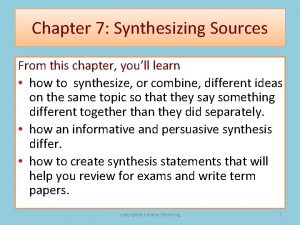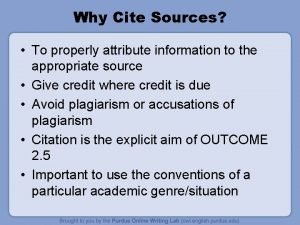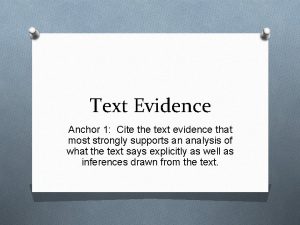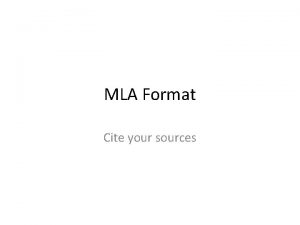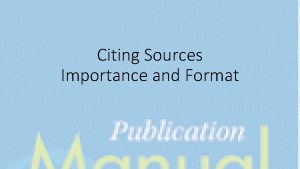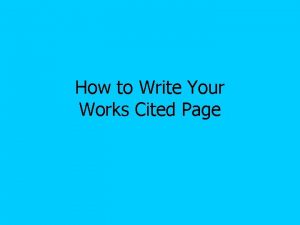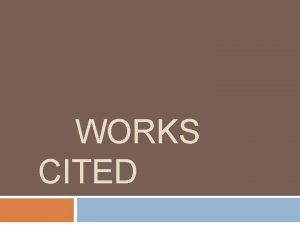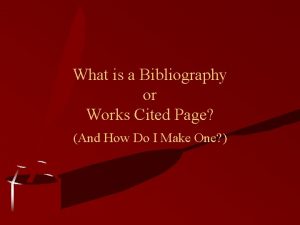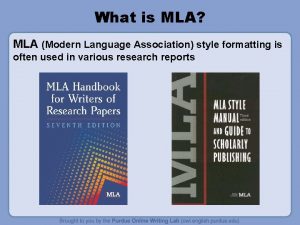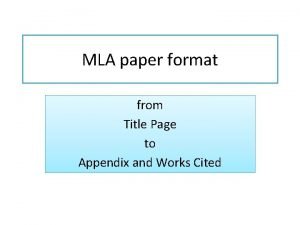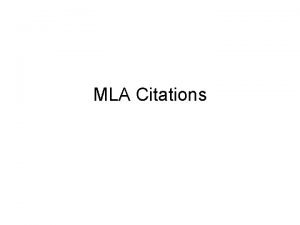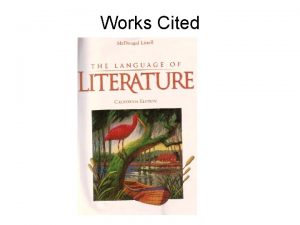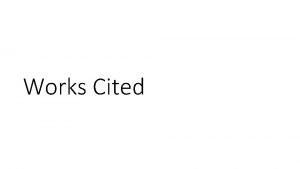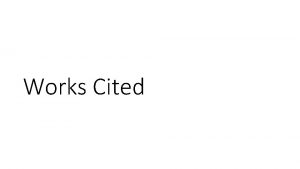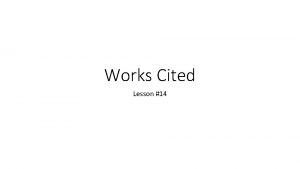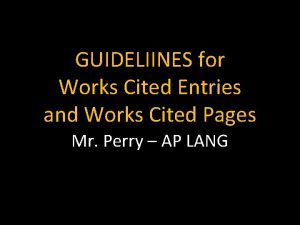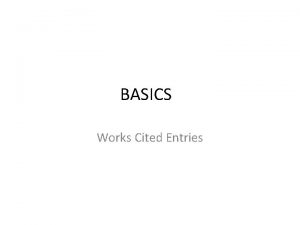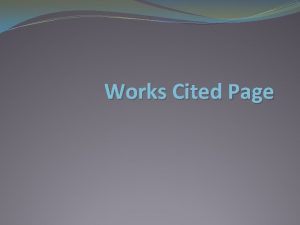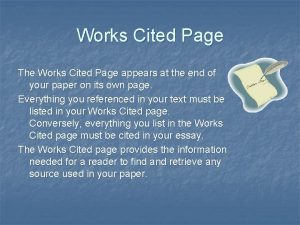CITING SOURCES Works Cited CITING SOURCES WORKS CITED













- Slides: 13

CITING SOURCES Works Cited

CITING SOURCES – WORKS CITED • You are responsible for listing all of the sources you use on research projects. • You should keep a list of all information you use from any book, website, magazine, etc. • You will need to record basic information from your sources in MLA format. • Your sources should be listed on a separate page (this should be the last page of your written report) and should appear alphabetically. • The title of your source page should be “Works Cited. ” The title should be centered and underlined.

CITING BOOKS • Publisher information, including location and date, is normally found on the back of the inside title page of any book. • You should include only the city of publication. • Skip a line between sources, and indent any text that goes beyond one line. • Citations should be formatted exactly like the examples. • Punctuation, spacing, italicizing, capitalization, etc. are all part of MLA formatting. • Author names and titles should be capitalized according to standard capitalization rules.

CITING BOOKS • Book titles should always be capitalized and should be underlined or appear in italics. In these examples, the book titles are italicized. • When writing a “Works Cited” page by hand, the titles would obviously have to be underlined instead. • Books with one author should be cited as follows: Lastname, Firstname. Title of Book. Place of Publication: Publisher, Year of Publication. Medium of Publication.

CITING BOOKS • Example: Hamilton, Edith. Mythology. Boston: Little, Brown and Company, 1942. Print. • NOTE: Books with no author should be cited as you would a normal book, but without an author name.

CITING BOOKS • Books with two authors should be cited as follows: Lastname, Firstname and Firstname Lastname. Title of Book. Place of Publication: Publisher, Year of Publication. Medium of Publication. • Example: Cussler, Clive and Thomas Perry. The Tombs: A Fargo Adventure. New York: Penguin Group, 2012. Print.

CITING BOOKS • Books with an editor should be cited as follows: Lastname, Firstname. Title of Book. Ed. Name. Place of Publication: Publisher, Year of Publication. Medium of Publication. • Example: Bronte, Charlotte. Jane Eyre. Ed. Margaret Smith. Oxford: Oxford UP, 1998. Print. • NOTE: “Ed. ” should appear before the editor’s name in all citations that have an editor.

CITING REFERENCE BOOKS • Reference books, such as dictionaries and encyclopedias, should be cited as follows: “Information Heading. ” Title of Book. Edition. Year of Publication. Medium of Publication. • Example: “Literature. " The American Heritage Dictionary. 3 rd ed. 1997. Print.

CITING ONLINE SOURCES • Online resources should be cited as follows: Main Website: Website Page. URL. Access Date. Medium of Publication. • Example: Britain Express: Medieval England – Daily Life in Medieval Towns. http: //www. britainexpress. com/History/Townlife. htm. April 7, 2008. Web. • NOTE: This is a modified version of MLA format.

CITING ONLINE SOURCES • REMEMBER: Google is NOT a source! • Google is a tool that helps you locate online resources about your topic. • The location where you actually obtained the information is the resource that should be cited.

WORKS CITED EXAMPLE • When finished, your “Works Cited” page should look like this: Works Cited Britain Express: Medieval England – Daily Life in Medieval Towns. http: //www. britainexpress. com/History/Townlife. htm. April 7, 2008. Web. Eastwood, Kay. Life in a Castle. New York: Crabtree Publishing Company, 2004. Print. Macdonald, Fiona. How Would You Survive in the Middle Ages? New York: Franklin Watts, 1997. Print. Pyle, Howard. The Story of King Arthur and His Knights. New York: Signet Classics, 2006. Print. Steele, Tara. Medieval Warfare. New York: Crabtree Publishing Company, 2004. Print. • NOTE: The “Works Cited” page should appear in the same font as the rest of your report, but should be formatted according to MLA guidelines.

OTHER RESOURCES • If you use another type of source, you are still required to cite it. Other sources include magazines, posters, interviews, brochures, etc. Please use the OWL at Purdue website or see me for information on how to cite other resources. http: //owl. english. purdue. edu/owl/search. php

YOUR RESPONSIBILITIES • You MUST include a “Works Cited” page at the end of any research project for my classes. You should include ALL sources used for your written report, oral presentation, and visual aid(s). • If you use resources for other types of projects, you should include a “Works Cited” page, like you would for a research project. • Use the OWL at Purdue website for more detailed information.
